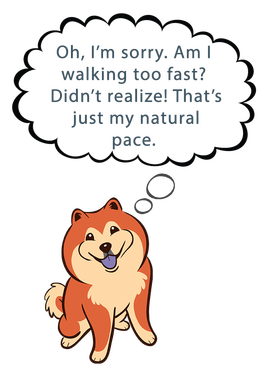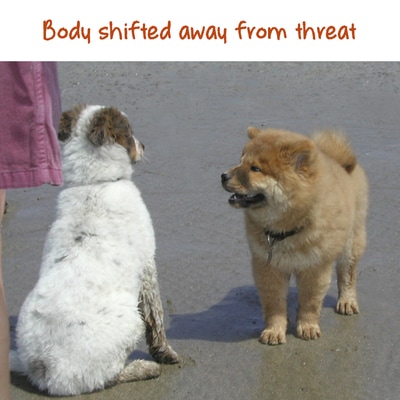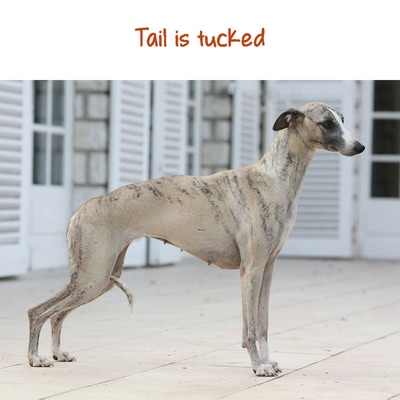Leash Issues
Going for walks with your pup is one of the most enjoyable parts of living with a dog — except when it isn't. Some dogs pull like the Wile E. Coyote chasing the Road Runner, others stop in their tracks and won't move a muscle, and some start out just fine and then go berserk when they see another dog.
Pulling to Get Somewhere

Occam's Razor says that the simplest explanation is often the correct one. And when dogs pull, it's usually because they walk faster than we do. Think of any time you've seen stray dogs walking down the street. They typically aren't walking at the same pace we humans do — they're trotting along briskly. Hey, they have four legs to propel them forward, and we only have two. It's no surprise they naturally walk faster!
Some dogs pull right from the start of the walk; others walk politely by your side until they see a dog friend or get close to the dog park. No matter the motivation, they are pulling because they want to walk at a faster pace.
Some dogs pull right from the start of the walk; others walk politely by your side until they see a dog friend or get close to the dog park. No matter the motivation, they are pulling because they want to walk at a faster pace.
Loose Leash Walking
In decades past, dogs were traditionally taught to heel — to stay glued to your side — for walks. While this skill is important for competition and show dogs, it's not necessarily ideal for most pet dogs.
Today, we focus instead on loose-leash walking, which teaches your dog to walk politely with you, but allows him to take in all the wonderful sights, sounds, and smells that he can experience on a walk. He can't do that if he's glued to your side.
Walks are about more than physical exercise. They provide mental stimulation, socialization, and enrichment for your dog. Allow him to investigate the environment, provided that he isn't dragging you down the street!
Today, we focus instead on loose-leash walking, which teaches your dog to walk politely with you, but allows him to take in all the wonderful sights, sounds, and smells that he can experience on a walk. He can't do that if he's glued to your side.
Walks are about more than physical exercise. They provide mental stimulation, socialization, and enrichment for your dog. Allow him to investigate the environment, provided that he isn't dragging you down the street!
How To Do It
|
To teach your dog not to pull on leash, you simply need to stop reinforcing him for pulling. Moving forward is reinforcing for dogs who pull, so each step you take while the leash is tight makes the pulling behavior stronger and stronger. It teaches your dog that pulling works.
The most efficient and humane training devices to teach dogs to walk politely are front-clip harnesses and head halters. |
|
Essentially, the dog wants to keep moving forward, but if he pulls, he ends up turned around facing the other direction. Each time he pulls, he stops being able to do the thing he wants, so he learns to stop pulling.
It's important to note that there are other devices marketed to teach dogs to stop pulling — i.e. choke, prong, and shock collars — that use pain and fear to do it. Aside from the question of whether it's ever acceptable to use pain and fear to train dogs, these devices can cause "fallout behaviors," such as aggression to other dogs or to people. Because of this, organizations including the American Veterinary Society of Animal Behavior and the Pet Professional Guild warn against using them.
It's important to note that there are other devices marketed to teach dogs to stop pulling — i.e. choke, prong, and shock collars — that use pain and fear to do it. Aside from the question of whether it's ever acceptable to use pain and fear to train dogs, these devices can cause "fallout behaviors," such as aggression to other dogs or to people. Because of this, organizations including the American Veterinary Society of Animal Behavior and the Pet Professional Guild warn against using them.
Stopping in Their Tracks
You and Sheila the Schnauzer are trotting along, and you happen upon a wooden bridge over a stream. Without warning, Sheila freezes. She'll go back to where you came from, but she won't take a step onto that bridge.
A natural reaction is to think that Sheila is being stubborn. But if you look closely at her body language, you'll likely see a different story:
A natural reaction is to think that Sheila is being stubborn. But if you look closely at her body language, you'll likely see a different story:
Sheila is actually scared. It could be a fear of heights or a smell emanating form the stream, or she could simply be afraid of walking on wood, if she hasn't experienced that before.
Pleading, punishing, and pulling from your end of the leash won't help a fearful pup start walking again. Instead you need to teach her that the scary bridge is not only something NOT to fear, but is actually a wonderfully fun place to be. A qualified trainer can help you do that.
Pleading, punishing, and pulling from your end of the leash won't help a fearful pup start walking again. Instead you need to teach her that the scary bridge is not only something NOT to fear, but is actually a wonderfully fun place to be. A qualified trainer can help you do that.
Leash Aggression
Dogs who seem to become aggressive on-leash when another dog is near could be upset by the dog itself, or they could actually be happy to see the dog, but frustrated that the leash is stopping them from visiting. Both of these situations fall under a category called reactivity, which is so worrisome to many dog guardians that it warrants its own page. Click here to read on.




